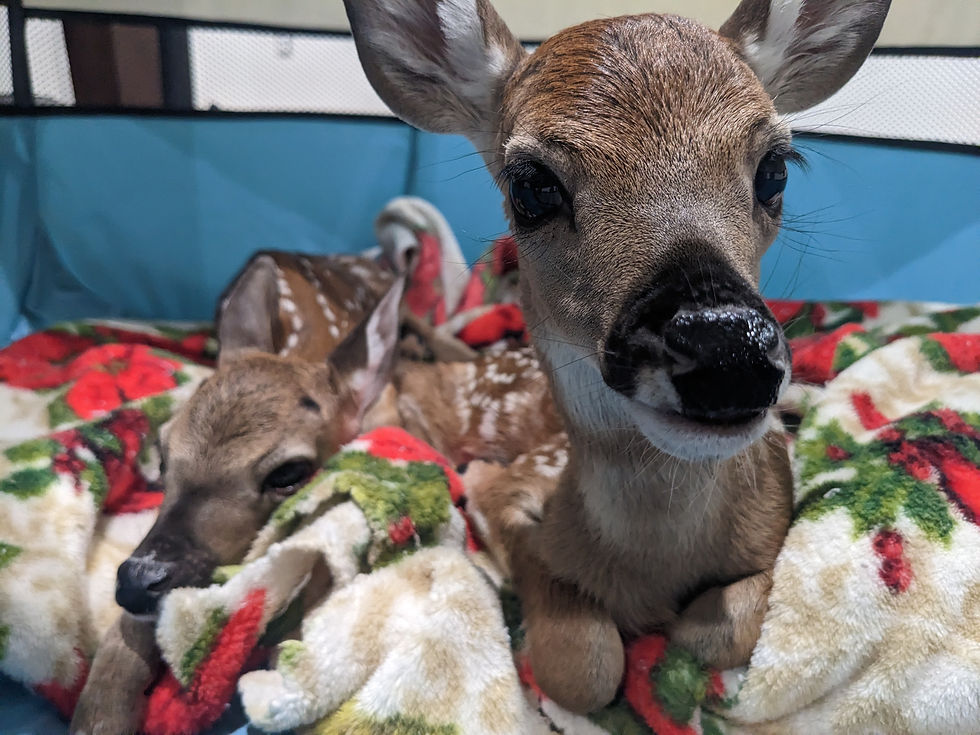Help, I Found A Fawn!
- jasmine7715
- May 15
- 3 min read
Updated: May 30

Deer live in all kinds of places in the United States—like forests, deserts, mountains, grasslands, swamps, and wetlands. They help nature in a lot of ways! When deer eat plants and move around, they spread seeds, which helps new plants grow. Since they eat a lot of grass and plants, they also help keep the environment from getting too overgrown. Plus, deer are an important food source for wild predators like wolves and mountain lions, which helps keep nature balanced. As with most wildlife, Spring is baby season for animals, including deer. Fawns are usually born between the months of May and June, but you could potentially see them any time between April and July!

If you happen to find a baby fawn you need to ask yourself a handful of questions: Does the baby seem injured or have any blood on them?
Is the fawn moving, or is it staying still?
Is the fawn curled up with their legs tucked in tight to their body, possibly with their head laying down over their back, or is the fawn on their side with their legs stretched out?
Is the fawn approaching or following humans or pets?
These questions can help you determine if you need to help the fawn or not.

If the fawn is curled up and laying still and not making any noise, this is a good sign that all is well. In the wild mothers will forage for food throughout the day and leave their baby in a place that they deem safe. This also keeps predators away from fawns, as they have no scent while young. So if you find one that is being quiet and still, this baby is healthy and doing what nature intended for them to do while mom eats nearby. Fawns know to stay quiet when their mother isn't around to ensure their safety.

But what do you do if you find a fawn and they are coming toward you or your pet? What about if it is injured? This baby needs help! Stay calm and approach the fawn slowly to avoid causing more stress. Use a towel or blanket to gently cover the fawn, which helps keep it calm and prevents it from kicking. Be sure to support the fawn’s entire body, keeping its legs tucked in to avoid injury. Place the fawn in a well-ventilated box or pet carrier lined with a towel, and keep the container in a quiet, dark space to minimize stress. Do not attempt to feed the fawn or give it water, as its digestive system is extremely sensitive and the wrong food could be harmful. Once settled, contact a wildlife rehabilitator as soon as possible and follow any instructions they may provide.

Remember, if you ever have to say "Help, I found a fawn!":
Capture - catch the injured or orphaned animal in a manner that is safe for both you and the wildlife
Contain - contain the animal in a large dog carrier or kennel
Warmth - place half of the kennel on top of a heating pad, place a bottle filled with hot water and wrapped in a towel inside the carrier, or use another source of heat to carefully warm the animal while allowing it to rest in a dark and quiet place away from children or pets, and limit handling.
Contact - Please reach out to us, your local game warden or wildlife officer, or another licensed wildlife rehabilitator to get further instructions. We can be reached via text at 903.636.3193, by call at 903.858.1008, or via our website here at www.tigercreek.org or www.awildlife.org.
***IMPORTANT*** Do NOT try to feed them or offer hydration without first speaking to one of our wildlife experts! Offering food, water, or formula of any kind can end up hurting or even killing the babies. The absolute best thing you can do for that baby when you get it contained is to get it warm, and contact us immediately.

Wildlife Rehabilitators do their best with every animal that comes into care, but we couldn't do it without YOU! Thank you for caring about wildlife!



